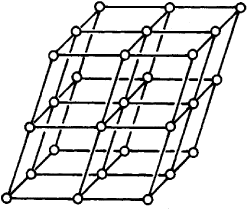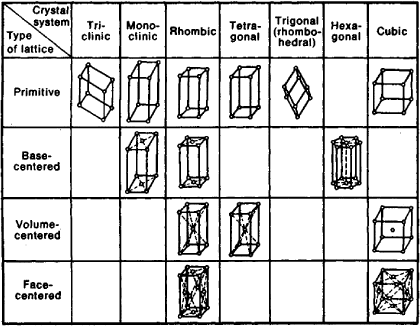Bravais Lattice
Also found in: Dictionary, Thesaurus, Wikipedia.
Bravais lattice
[brə′vā ′lad·əs]Bravais Lattice
a type of spatial crystal lattice first described by the French scientist A. Bravais in 1848. Bravais expressed the hypothesis that spatial crystal lattices are constructed of regularly spaced node-points (where the atoms are located) that can be obtained by repeating a given point by means of parallel transpositions (translations). (See Figure 1.) When straight lines and planes are constructed

through these points, the spatial lattice becomes divided into equal parallelepipeds (cells). There are a total of 14 types of such lattices, by which the structure of any crystal can be described in the first approximation. Bravais lattices are divided into four types (Figure 2):
(1) primitive, in which the points occur only at the vertices of the parallelepiped;
(2) base-centered, having an additional point in each of the centers of two opposite faces;
(3) volume-centered, in which a point in the center of the cell is added to the primitive type;
(4) face-centered, having one point in the center of each face.

Bravais lattices are distributed among the crystal systems as follows: the triclinic system has one; the monoclinic, two; the tetragonal, two; the rhombic, four; the trigonal (rhombohedral), one; the hexagonal, one; and the cubic, three.